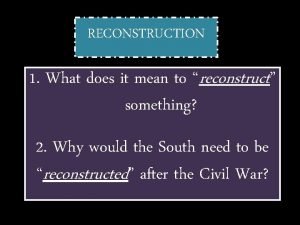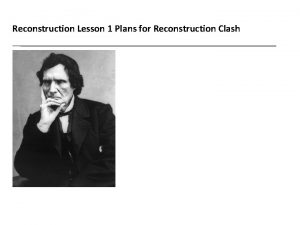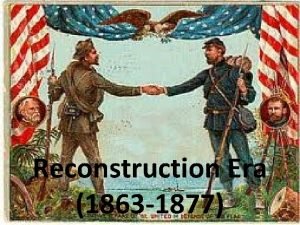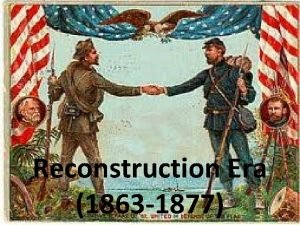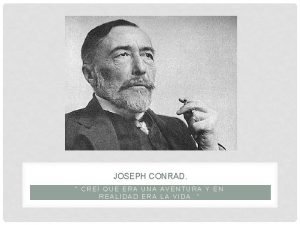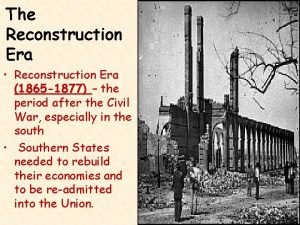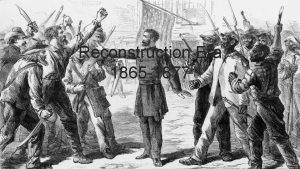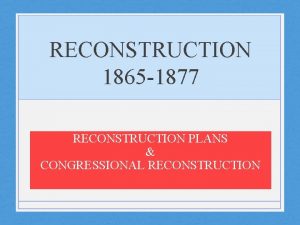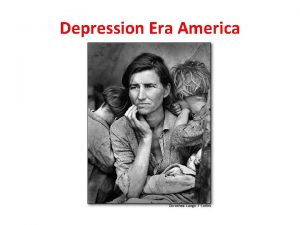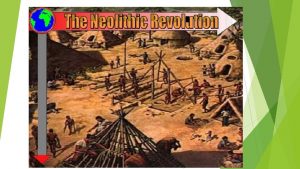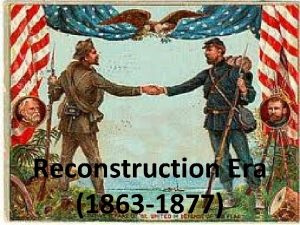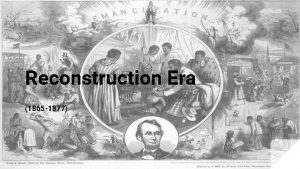The Reconstruction Era Part I Plans for Reconstruction









































































- Slides: 73

The Reconstruction Era Part I Plans for Reconstruction


The 11 Southern states that had decided to leave the Union in 1860 and 1861 were basket cases by 1865. Only Texas, where there had not been that much fighting, was in relatively decent shape.

Southern cities such as Atlanta, Charleston, and Richmond were in ruins.


Few businesses of any kind were still operating. Little capital was available to start new businesses, Few outsiders were willing to risk investing in the area.

For example, 7, 000 miles of railroad track were laid in the South between 1865 and 1879. In the rest of the country, 45, 000 miles were laid.

Before the war, the South’s economy had been based almost strictly on agriculture, mainly cotton, tobacco, and sugar, and all these industries suffered, especially cotton.

Southern cotton production in 1870 was half what it was in 1860.

The educational system in the South had virtually disappeared, along with the old plantation system.

More than 250, 000 of the South’s young men were gone, too.

“Pretty much the whole of life has been merely not dying, ” wrote the Southern poet, Sidney Lanier, about the Reconstruction period.

By the end of 1865, a triumphant North faced the problem of how to reconstruct the South.

It had to decide how to treat the former Confederate states and their leaders, as well as what to do with the slaves set free by the Thirteenth Amendment.

Another issue was whether the president or Congress had the authority to deal with the defeated South.

Reconstruction refers to these post-war years, from 1865 – 1877, when Northern troops occupied the defeated South and tried to reshape their state governments, so they could rejoin the Union.


Lincoln’s Ten Percent Plan

After major Union victories at the battles of Gettysburg and Vicksburg in 1863, President Abraham Lincoln began preparing his plan for reconstruction to reunify the North and South after the war’s end.

Under Lincoln’s plan, 10 percent of state voters … had to take an oath of allegiance to the United States to be readmitted to the Union.

He offered full presidential pardons to all southerners, except high-ranking Confederate military and civilian leaders, who took the loyalty oath and agreed to the abolition of slavery.

Radical Republicans in Congress rejected Lincoln’s lenient policy.

In 1864, Congress passed the Wade Davis Bill, which required that at least 50 percent of a state’s white, male population take an oath of loyalty to the Union.

Lincoln refused to sign it and vetoed it after Congress adjourned.

The bullet that killed Abraham Lincoln at the end of the Civil War may also have killed any chance of coming up with a practical solution toward putting the country back together – and figuring out what to do with 3. 5 million former slaves who had won their freedom but not much else.

Andrew Johnson’s Plan

Andrew Johnson of Tennessee became president after Lincoln’s assassination.

In 1864, the Democrat Johnson had been selected by the Republican Lincoln as his running mate in order to encourage pro-Union Democrats to vote for the Republican Party and attract more overall voters to the ticket.


Let’s look more closely at Andrew Johnson

Andrew Johnson may have been the poorest president ever, at least in terms of his humble beginnings.

Born in North Carolina to impoverished parents, his father died when Johnson was just 3 years old. He never went to school and instead became a tailor’s apprentice at the age of 14.

Johnson was born in Raleigh

Johnson taught himself to read and became involved in politics at the age of 17. When the Civil War broke out, Lincoln appointed Johnson military governor of Tennessee.

When Lincoln was killed, the country was left with a stubborn and ill-tempered president who had none of Lincoln’s gift of leadership.

Johnson did not like blacks, did not like rich Southerners, and did not like the Republican-controlled Congress.

In 1866, Johnson took what was called a “Swing around the Circle, ” travelling around the Northern states to campaign for Democrats running for Congress and against the 14 th Amendment, which would give blacks full citizenship.

Johnson’s “Swing around the Circle” was a disaster. The president was booed and jeered by Northern crowds who viewed him as a pro-South bozo.

The Republicans dominated the election and had such overwhelming majorities in Congress that they easily passed any bill they wanted – and then just as easily overrode Johnson’s vetoes.

Johnson’s reconstruction plan was similar to Lincoln’s

Northern Republicans distrusted Johnson because he had been a Democrat from Tennessee, a seceding southern state

Johnson also angered many Republicans, because he granted presidential pardons to wealthy planters.

As a result, many former Confederate leaders were back in Washington by the end of 1865.

For example, Alexander Stephens, the ex-Confederate vice-president who was in federal prison awaiting trial on treason charges. That kind of in-your-face attitude irritated the Radical Republicans, who felt Southerners were not sorry enough for causing the war.


“Oh I’m a good old rebel Now that’s just what I am; For the ‘fair land of freedom, I do not care a damn. I’m glad I fought agin it I only wish we’d won And I don’t want a pardon For anything I’ve done. -- Popular Southern song, 1865 - 1866

Radical Republicans Program

The Radical Republicans, led by Charles Summer of Massachusetts in the Senate and Thaddeus Stevens of Pennsylvania in the House, wanted to punish the South for its role in the war.

Thaddeus Stevens • One of the most sincere white men in America when it came to rights for African Americans • Stevens was an honest politician • He was unmoved by either flattery or criticism • He was also fanatical in his hatred of the South • (a hatred fueled in part by the destruction of his Pennsylvania factory by Southern troops on their way to Gettysburg) • Stevens never married, but for years he had a black housekeeper who was rumored to his lover

Thaddeus Stevens • As the most radical of the Radical Republicans, Stevens virtually led the country for more than a year because of his power in Congress. • He advocated taking the land from the South’s wealthiest plantation owners and dividing it among former slaves. • (that was too radical for even his colleagues) • He did successfully push for other laws designed to protect the basic rights of African Americans • When Stevens died in 1868, he was buried in a black cemetery

His epitaph read, “I have chosen this that I might illustrate in my death the principles which I advocated through a long life: Equality of Man before his Creator. ”

Stevens and the Radical Republicans wanted to insure that blacks received the same rights as whites.

To accomplish these goals, they promoted a program that included several major pieces of reform legislation.

The Freedmen’s Bureau

Few former slaves had any education or training.

Some thought freedom meant freedom from work; others were fearful that to continue working for white people would put them in danger of being enslaved again. And many believed a widespread rumor that the federal government would be giving each slave “ 40 acres and a mule” to start their own farms (such a plan never existed)

But, in 1865, the federal government did organize the Freedmen’s Bureau It helped ex-slaves get employment, education, and emergency assistance in the form of clothing and food.

From 1865 to 1868, the bureau helped as many as 200, 000 former slaves learn to read.

About 10, 000 black families were settled by the bureau on land that had been confiscated by Union troops, although most of them were eventually forced off the land by whites who swindled them out of it or used dubious legal means.

A bill extending the bureau was vetoed by President Johnson in 1866, but Congress overrode his veto


The Civil Rights Act of 1866

Many Northerners were angry at the South’s imposition on African Americans that became known as the “black codes” … laws that imposed severe restrictions on freed slaves in the former Confederate states.

The black codes… denied former slaves the right to vote or sit on juries, limited their right to testify against white men, and prohibited them from carrying weapons in public, working in certain occupations, and travelling without a permit.

Southerners argued that these codes were necessary to maintain order.

They varied from state to state They did give blacks some rights they had not had before, such as the power to sue in court, own certain kinds of property, and legally marry.

But the Black Codes also prohibited blacks from bearing arms, working in most occupations other than farming or manual labor, and leaving their jobs without permission.

They restricted African Americans’ right to travel and fined them if they broke any of the codes.

To the Radical Republicans, even many moderate Northerners, the Black Codes were simply a substitute for slavery.

To combat the Black Codes, Congress passed a series of bills designed to strengthen the rights of blacks.

The Civil Rights Act of 1866 granted freedmen all the rights and benefits of U. S. citizens and noted that federal troops would enforce these rights.

The Civil Rights Act also helped enforce the Thirteenth Amendment

Johnson vetoed the Civil Rights Act, but Congress overrode his veto.
 Presidential and radical reconstruction venn diagram
Presidential and radical reconstruction venn diagram Reconstruction plans venn diagram
Reconstruction plans venn diagram Korean war vietnam war venn diagram
Korean war vietnam war venn diagram Reconstruction lesson plans
Reconstruction lesson plans Define reconstruction era
Define reconstruction era Define compromise of 1877
Define compromise of 1877 Reconstruction era
Reconstruction era Creí que era una aventura y en realidad era la vida
Creí que era una aventura y en realidad era la vida Vi uma estrela tão alta
Vi uma estrela tão alta Baroque music quiz
Baroque music quiz Victorian and elizabethan era
Victorian and elizabethan era Kassaregister ideell förening
Kassaregister ideell förening Blomman för dagen drog
Blomman för dagen drog Borra hål för knoppar
Borra hål för knoppar Mat för idrottare
Mat för idrottare Texter för hinduer tantra
Texter för hinduer tantra Vad är ett minoritetsspråk
Vad är ett minoritetsspråk Ledarskapsteorier
Ledarskapsteorier Publik sektor
Publik sektor Antikt plagg
Antikt plagg Ellika andolf
Ellika andolf Datorkunskap för nybörjare
Datorkunskap för nybörjare Steg för steg rita
Steg för steg rita Redogör för vad psykologi är
Redogör för vad psykologi är Ministerstyre för och nackdelar
Ministerstyre för och nackdelar Sju principer för tillitsbaserad styrning
Sju principer för tillitsbaserad styrning Tack för att ni lyssnade bild
Tack för att ni lyssnade bild Bästa kameran för astrofoto
Bästa kameran för astrofoto Dikt om ljus
Dikt om ljus Nyckelkompetenser för livslångt lärande
Nyckelkompetenser för livslångt lärande Personlig tidbok
Personlig tidbok Modell för handledningsprocess
Modell för handledningsprocess Orubbliga rättigheter
Orubbliga rättigheter Meios steg för steg
Meios steg för steg Verktyg för automatisering av utbetalningar
Verktyg för automatisering av utbetalningar Kanaans land
Kanaans land Expektans eller exspektans
Expektans eller exspektans Jag har gått inunder stjärnor text
Jag har gått inunder stjärnor text Stig kerman
Stig kerman Ro i rom pax
Ro i rom pax Varför kallas perioden 1918-1939 för mellankrigstiden
Varför kallas perioden 1918-1939 för mellankrigstiden Ledningssystem för verksamhetsinformation
Ledningssystem för verksamhetsinformation Borstål, egenskaper
Borstål, egenskaper Tack för att ni har lyssnat
Tack för att ni har lyssnat Läkarutlåtande för livränta
Läkarutlåtande för livränta Karttecken höjdkurva
Karttecken höjdkurva Ekologiskt fotavtryck
Ekologiskt fotavtryck Centrum för kunskap och säkerhet
Centrum för kunskap och säkerhet Inköpsprocessen steg för steg
Inköpsprocessen steg för steg Påbyggnader för flakfordon
Påbyggnader för flakfordon Strategi för svensk viltförvaltning
Strategi för svensk viltförvaltning Sura för anatom
Sura för anatom Egg för emanuel
Egg för emanuel Formula varians
Formula varians Bris för vuxna
Bris för vuxna Rutin för avvikelsehantering
Rutin för avvikelsehantering Kontinuitetshantering i praktiken
Kontinuitetshantering i praktiken Klassificeringsstruktur för kommunala verksamheter
Klassificeringsstruktur för kommunala verksamheter Myndigheten för delaktighet
Myndigheten för delaktighet Debatt mall
Debatt mall Tack för att ni lyssnade
Tack för att ni lyssnade En lathund för arbete med kontinuitetshantering
En lathund för arbete med kontinuitetshantering Tobinskatten för och nackdelar
Tobinskatten för och nackdelar Hur ser ett referat ut
Hur ser ett referat ut Atmosfr
Atmosfr Programskede byggprocessen
Programskede byggprocessen Lek med former i förskolan
Lek med former i förskolan Presentera för publik crossboss
Presentera för publik crossboss Rbk mätning
Rbk mätning Vätsketryck formel
Vätsketryck formel Elektronik för barn
Elektronik för barn Kung som dog 1611
Kung som dog 1611 Densitet vatten
Densitet vatten Tack för att ni har lyssnat
Tack för att ni har lyssnat

